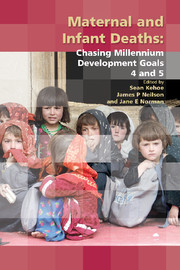Book contents
- Frontmatter
- Contents
- Participants
- Declaration of personal interests
- Preface
- The Millennium Development Goals
- SECTION 1 THE SIZE OF THE PROBLEM
- SECTION 2 CLINICAL PROBLEMS AND SOLUTIONS – MATERNAL
- 5 Postpartum haemorrhage
- 6 Reducing deaths from hypertensive disorders of pregnancy
- 7 Obstructed labour (including partograms)
- 8 Puerperal sepsis in low- and middle-income settings: past, present and future
- 9 Unsafe abortion and strategies to reduce its impact on women's lives
- 10 HIV and tuberculosis
- 11 A pragmatic approach to safe anaesthesia
- SECTION 3 CLINICAL PROBLEMS AND SOLUTIONS – NEONATAL
- SECTION 4 TRAINING AND DEVELOPMENT
- SECTION 5 SPECIFIC CHALLENGES IN SPECIFIC COUNTRIES
- SECTION 6 CONSENSUS VIEWS
- Index
7 - Obstructed labour (including partograms)
from SECTION 2 - CLINICAL PROBLEMS AND SOLUTIONS – MATERNAL
Published online by Cambridge University Press: 05 February 2014
- Frontmatter
- Contents
- Participants
- Declaration of personal interests
- Preface
- The Millennium Development Goals
- SECTION 1 THE SIZE OF THE PROBLEM
- SECTION 2 CLINICAL PROBLEMS AND SOLUTIONS – MATERNAL
- 5 Postpartum haemorrhage
- 6 Reducing deaths from hypertensive disorders of pregnancy
- 7 Obstructed labour (including partograms)
- 8 Puerperal sepsis in low- and middle-income settings: past, present and future
- 9 Unsafe abortion and strategies to reduce its impact on women's lives
- 10 HIV and tuberculosis
- 11 A pragmatic approach to safe anaesthesia
- SECTION 3 CLINICAL PROBLEMS AND SOLUTIONS – NEONATAL
- SECTION 4 TRAINING AND DEVELOPMENT
- SECTION 5 SPECIFIC CHALLENGES IN SPECIFIC COUNTRIES
- SECTION 6 CONSENSUS VIEWS
- Index
Summary
Introduction
Obstructed labour is an important cause of maternal and perinatal mortality and in the developing world it always features among the top five causes of maternal deaths. Globally, obstructed labour was responsible for 8% of maternal deaths in 2000. The maternal and neonatal morbidity is also significant. In 1990, obstructed labour was ranked 41st in the World Health Organization (WHO) Global Burden of Disease, which represented 0.5% of the burden of all conditions and 22% of all maternal conditions. Using the disability-adjusted life year indicator, it was estimated to be the condition that results in the most morbidity out of all maternal complications. However, it is one of the complications with the most potential for prevention. Unlike haemorrhage or eclampsia, it takes days rather than hours for maternal mortality or morbidity to occur in association with obstructed labour. For achieving Millennium Development Goals (MDGs) 4 and 5, it is important that this eminently preventable complication be addressed. The contribution of a functioning health system in reducing the risk from obstructed labour is shown by the fact that both the immediate and long-term sequelae of this complication are virtually non-existent in developed countries.
Definition
Obstructed labour is defined as the failure of progress in labour due to mechanical factors, in the presence of good contractions of the uterus. There is no difficulty in detecting severe cases of obstructed labour but minor degrees may escape detection.
- Type
- Chapter
- Information
- Maternal and Infant DeathsChasing Millennium Development Goals 4 and 5, pp. 115 - 130Publisher: Cambridge University PressPrint publication year: 2010



